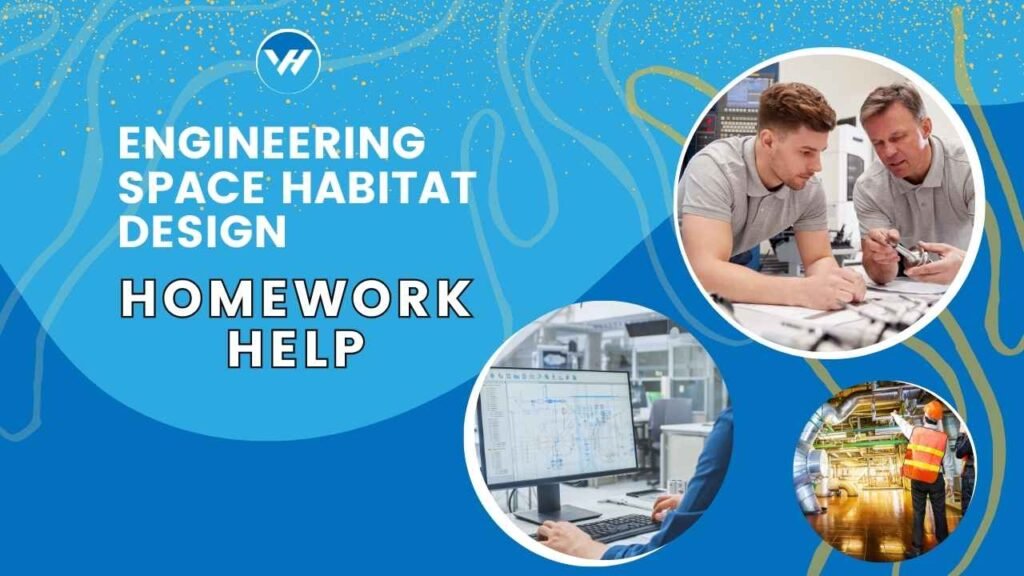Have you ever imagined living in space? How would you design a home that’s not on Earth but floating in the vastness of the universe? Welcome to the fascinating world of space habitat design! It’s an exciting field that combines science fiction with hardcore engineering principles. In this article, we’ll dive into the essentials of space habitat design, the challenges engineers face, and how you can ace your homework in this futuristic subject with a little help from Virtual Help.

Table of Contents
ToggleWhat is Space Habitat Design?
Definition and Concept
Space habitat design is all about creating livable environments for humans in outer space. It involves designing structures that can support life, provide comfort, and ensure safety far from our home planet.
Historical Background
The idea of living in space isn’t new. It dates back to the mid-20th century when visionaries like Wernher von Braun and Gerard K. O’Neill proposed concepts for space colonies. Over the years, these ideas have evolved with advancements in technology and our understanding of space.
Modern Space Habitats
Today, we have real examples like the International Space Station (ISS), which serves as a model for future space habitats. These modern structures are complex, requiring innovative solutions to ensure the well-being of their inhabitants.
Key Elements of Space Habitat Design
Structural Design
Creating a structure that can withstand the harsh conditions of space, including microgravity and extreme temperatures, is crucial. Materials used must be lightweight yet incredibly strong.
Life Support Systems
These systems are the lifeblood of any space habitat, providing essential functions like air, water, and food. Engineers must ensure these systems are fail-proof and can sustain life for extended periods.
Energy and Power Systems
Powering a space habitat requires reliable and efficient energy sources. Solar panels and fuel cells are commonly used, but future designs may incorporate nuclear or other advanced technologies.
Human Factors and Ergonomics
Designing for human comfort and productivity is essential. This includes everything from the layout of living quarters to the design of workspaces and recreational areas.
Challenges in Space Habitat Design
Microgravity
Living in a microgravity environment affects the human body in many ways, including muscle atrophy and bone density loss. Engineers must design habitats that help mitigate these effects.
Radiation Protection
Space is filled with harmful radiation. Effective shielding is necessary to protect inhabitants from long-term exposure, which can lead to serious health issues.
Limited Resources
Resource management is critical in space. Engineers must develop efficient recycling systems for air, water, and waste to ensure sustainability.
Psychological Factors
Isolation and confinement can take a toll on mental health. Creating environments that support psychological well-being is just as important as physical safety.
The Role of Engineers in Space Habitat Design
Multidisciplinary Approach
Space habitat design requires expertise from various engineering disciplines, including mechanical, electrical, and environmental engineering. Collaboration is key.
Collaboration with Scientists and Astronauts
Engineers work closely with scientists and astronauts to understand the practical needs and challenges of living in space. Their input is invaluable in designing effective habitats.
Use of Advanced Technologies
From 3D printing to AI-driven systems, engineers use cutting-edge technologies to solve complex problems and improve the efficiency and safety of space habitats.
Importance of Space Habitat Design Homework
Building Foundational Knowledge
Homework assignments help students grasp the fundamental concepts of space habitat design, laying the groundwork for future learning and career development.
Encouraging Innovation and Creativity
Assignments often challenge students to think creatively and propose innovative solutions to real-world problems, fostering a spirit of innovation.
Preparing for Future Careers
Understanding space habitat design opens doors to exciting career opportunities in aerospace engineering, space exploration, and beyond.
Common Topics in Space Habitat Design Assignments
Materials and Construction Methods
Exploring the best materials and construction techniques for building space habitats is a common assignment topic. Students learn about the properties and applications of various materials.
Sustainability in Space
Designing sustainable habitats that can recycle resources and minimize waste is crucial for long-term space missions. This topic covers the principles of sustainability and practical applications.
Simulation and Modeling
Students often use software to simulate space habitat designs, testing their functionality and efficiency. This helps them understand the practical challenges and refine their designs.
Tips for Excelling in Space Habitat Design Homework
Understanding the Assignment Requirements
Before starting, make sure you understand what’s expected. Read the assignment guidelines carefully and ask questions if anything is unclear.
Conducting Thorough Research
Gather information from reliable sources, including textbooks, scientific journals, and reputable websites. Understanding the latest developments in space habitat design is crucial.
Utilizing Online Resources
There are many online resources, including video tutorials, forums, and databases, that can help you with your assignments. Take advantage of these tools.
Seeking Help When Needed
Don’t hesitate to ask for help if you’re stuck. Your teachers, classmates, and online tutoring services like Virtual Help are there to assist you.
How Virtual Help Can Assist with Space Habitat Design Homework
Access to Expert Tutors
Virtual Help connects you with experienced tutors who specialize in space habitat design and other engineering fields. They can provide personalized guidance and support.
Personalized Learning Plans
Virtual Help offers customized learning plans tailored to your needs and learning style, helping you understand complex concepts more effectively.
24/7 Availability
With Virtual Help, you can get assistance whenever you need it, whether it’s early in the morning or late at night. This flexibility is perfect for managing your study schedule.
Use of Advanced Tools and Resources
Virtual Help provides access to advanced tools and resources, including simulation software and interactive learning materials, to enhance your understanding of space habitat design.
Real-World Applications of Space Habitat Design
International Space Station
The ISS is a prime example of a successful space habitat. Studying its design and operation offers valuable lessons for future projects.
Lunar Bases
Plans for lunar bases are underway, aiming to establish a permanent human presence on the Moon. These projects will benefit from advances in space habitat design.
Mars Colonization
Designing habitats for Mars presents unique challenges due to its harsh environment. Engineers are working on innovative solutions to make Mars colonization feasible.
Future Trends in Space Habitat Design
Innovative Materials
The development of new materials, such as lightweight composites and self-healing materials, will revolutionize space habitat design, making structures more durable and efficient.
Autonomous Systems
Autonomous systems, including robots and AI-driven maintenance systems, will play a crucial role in the operation and upkeep of space habitats.
Sustainable Practices
Sustainability will remain a key focus, with new technologies aimed at improving resource recycling and reducing the environmental impact of space habitats.
Benefits of Using Virtual Help for Engineering Assignments
Improved Understanding and Grades
With the personalized support from Virtual Help, you can improve your understanding of complex topics and achieve better grades.
Time Management
Virtual Help’s flexible scheduling allows you to manage your time effectively, balancing your studies with other commitments.
Stress Reduction
Having access to expert guidance can reduce the stress and anxiety often associated with challenging assignments, making your learning experience more enjoyable.
Conclusion
Designing habitats in space is an exciting and challenging field that requires a solid understanding of engineering principles and innovative thinking. Whether you’re working on a homework assignment or pursuing a career in this area, resources like Virtual Help can provide the support you need to succeed. So, dive into the world of space habitat design, embrace the challenges, and let your imagination soar. And remember, whenever you need a helping hand, Virtual Help is just a click away.
FAQs
What is the importance of space habitat design?
Space habitat design is crucial for ensuring the safety, comfort, and well-being of humans living and working in space. It involves creating environments that can sustain life in the harsh conditions of space.
How can Virtual Help assist with engineering assignments?
Virtual Help offers personalized tutoring, 24/7 support, and access to advanced tools and resources, making it easier for students to understand complex concepts and complete their assignments successfully.
What are the key challenges in space habitat design?
Key challenges include dealing with microgravity, radiation protection, limited resources, and addressing psychological factors to ensure the mental well-being of inhabitants.
What topics are commonly covered in space habitat design homework?
Common topics include materials and construction methods, sustainability, simulation and modeling, and case studies of existing habitats like the International Space Station.
How can students improve their performance in space habitat design assignments?
Students can improve their performance by understanding the assignment requirements, conducting thorough research, utilizing online resources, and seeking help from services like Virtual Help when needed.





